Detailed Engineering Design: Football Stadium Proposal for Qatar 2022
VerifiedAdded on 2023/06/10
|16
|3008
|352
Report
AI Summary
This engineering science report proposes a design for a football stadium for the 2022 World Cup in Qatar, focusing on sustainable materials and electrical components. The report details the eight stages of construction, from pre-design to development, emphasizing the selection of appropriate concrete materials based on composition, strength, and durability testing. It explores various non-destructive and partial destructive testing methods to assess concrete quality, including slump tests, compression tests, pull-out tests, and core tests. The report also addresses the stadium's electrical power requirements, advocating for energy-efficient LED lighting and the integration of a renewable energy system, specifically solar panels, to power portions of the stadium. Furthermore, it includes an analysis of temperature data and calculations related to electrical circuits within the stadium. Desklib offers a wide range of study resources, including past papers and solved assignments, to support students in their academic endeavors.
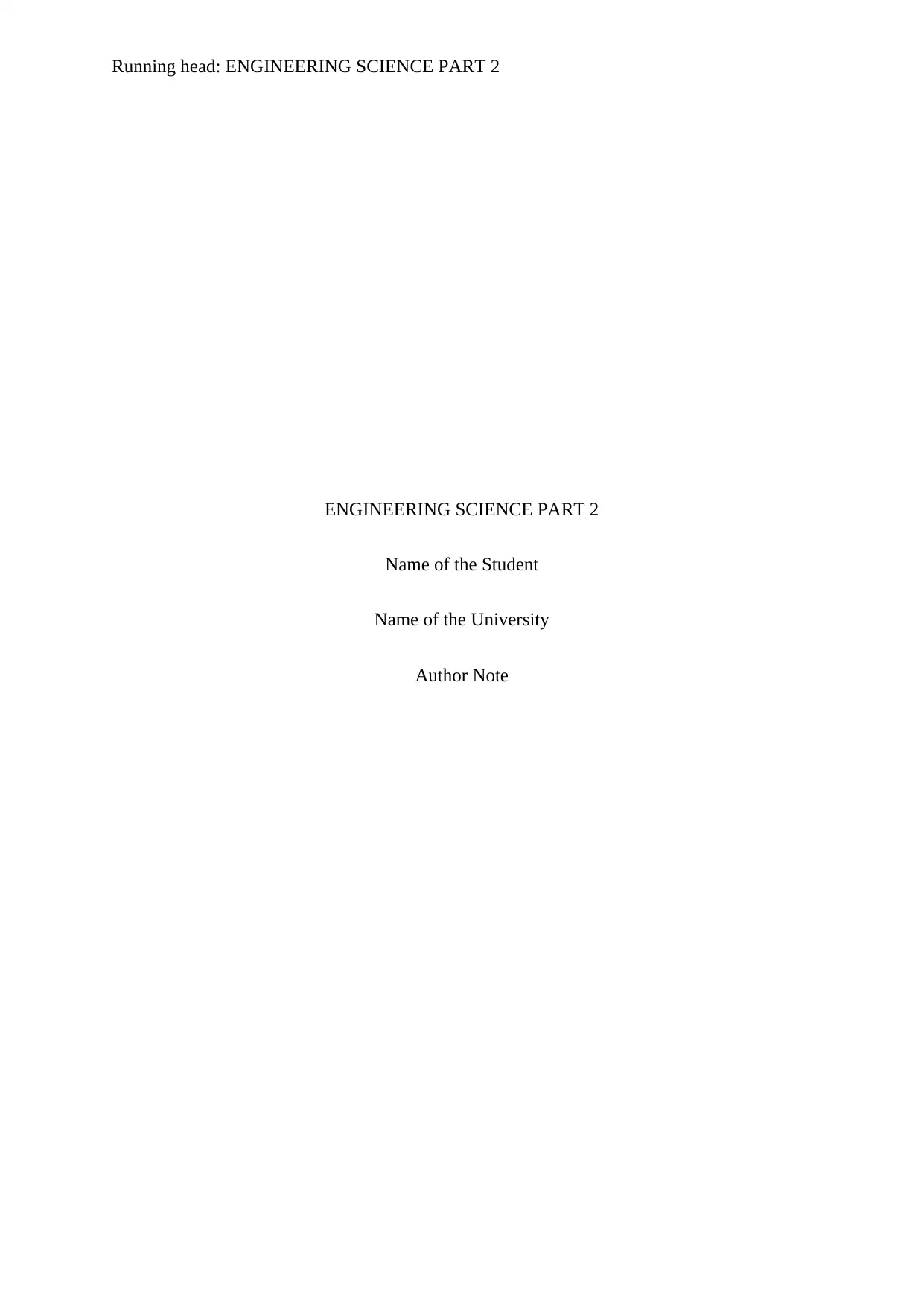
Running head: ENGINEERING SCIENCE PART 2
ENGINEERING SCIENCE PART 2
Name of the Student
Name of the University
Author Note
ENGINEERING SCIENCE PART 2
Name of the Student
Name of the University
Author Note
Paraphrase This Document
Need a fresh take? Get an instant paraphrase of this document with our AI Paraphraser
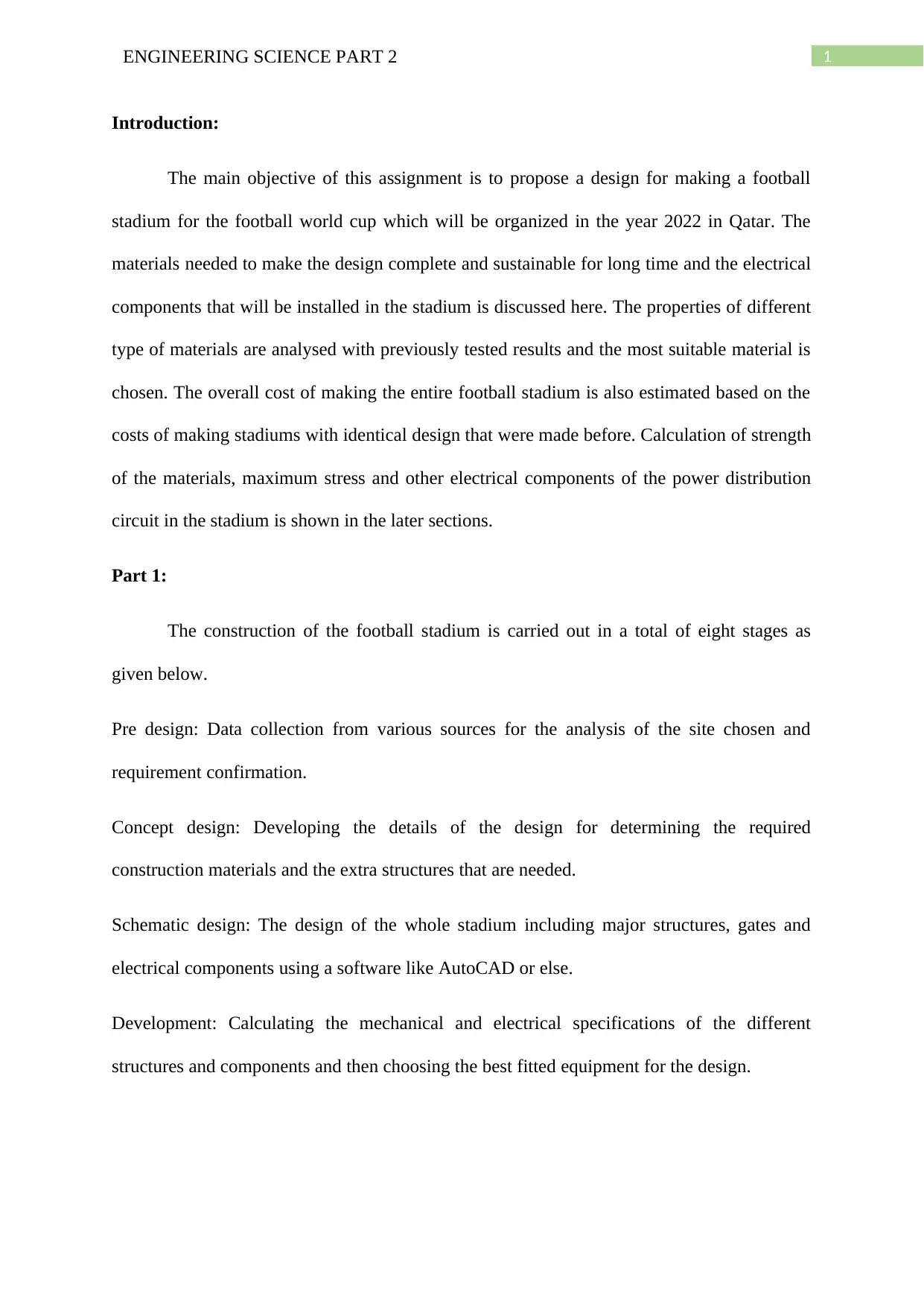
1ENGINEERING SCIENCE PART 2
Introduction:
The main objective of this assignment is to propose a design for making a football
stadium for the football world cup which will be organized in the year 2022 in Qatar. The
materials needed to make the design complete and sustainable for long time and the electrical
components that will be installed in the stadium is discussed here. The properties of different
type of materials are analysed with previously tested results and the most suitable material is
chosen. The overall cost of making the entire football stadium is also estimated based on the
costs of making stadiums with identical design that were made before. Calculation of strength
of the materials, maximum stress and other electrical components of the power distribution
circuit in the stadium is shown in the later sections.
Part 1:
The construction of the football stadium is carried out in a total of eight stages as
given below.
Pre design: Data collection from various sources for the analysis of the site chosen and
requirement confirmation.
Concept design: Developing the details of the design for determining the required
construction materials and the extra structures that are needed.
Schematic design: The design of the whole stadium including major structures, gates and
electrical components using a software like AutoCAD or else.
Development: Calculating the mechanical and electrical specifications of the different
structures and components and then choosing the best fitted equipment for the design.
Introduction:
The main objective of this assignment is to propose a design for making a football
stadium for the football world cup which will be organized in the year 2022 in Qatar. The
materials needed to make the design complete and sustainable for long time and the electrical
components that will be installed in the stadium is discussed here. The properties of different
type of materials are analysed with previously tested results and the most suitable material is
chosen. The overall cost of making the entire football stadium is also estimated based on the
costs of making stadiums with identical design that were made before. Calculation of strength
of the materials, maximum stress and other electrical components of the power distribution
circuit in the stadium is shown in the later sections.
Part 1:
The construction of the football stadium is carried out in a total of eight stages as
given below.
Pre design: Data collection from various sources for the analysis of the site chosen and
requirement confirmation.
Concept design: Developing the details of the design for determining the required
construction materials and the extra structures that are needed.
Schematic design: The design of the whole stadium including major structures, gates and
electrical components using a software like AutoCAD or else.
Development: Calculating the mechanical and electrical specifications of the different
structures and components and then choosing the best fitted equipment for the design.
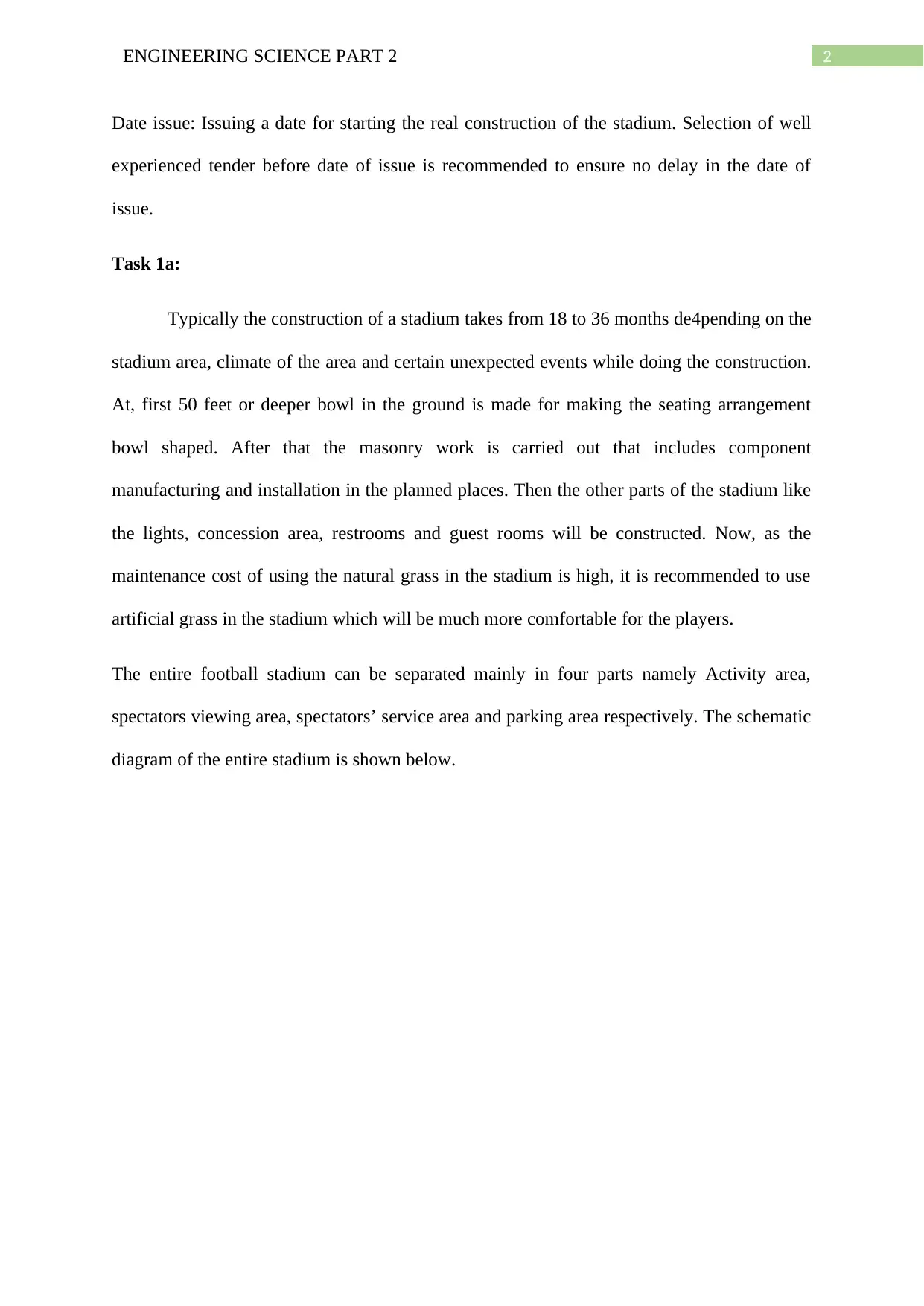
2ENGINEERING SCIENCE PART 2
Date issue: Issuing a date for starting the real construction of the stadium. Selection of well
experienced tender before date of issue is recommended to ensure no delay in the date of
issue.
Task 1a:
Typically the construction of a stadium takes from 18 to 36 months de4pending on the
stadium area, climate of the area and certain unexpected events while doing the construction.
At, first 50 feet or deeper bowl in the ground is made for making the seating arrangement
bowl shaped. After that the masonry work is carried out that includes component
manufacturing and installation in the planned places. Then the other parts of the stadium like
the lights, concession area, restrooms and guest rooms will be constructed. Now, as the
maintenance cost of using the natural grass in the stadium is high, it is recommended to use
artificial grass in the stadium which will be much more comfortable for the players.
The entire football stadium can be separated mainly in four parts namely Activity area,
spectators viewing area, spectators’ service area and parking area respectively. The schematic
diagram of the entire stadium is shown below.
Date issue: Issuing a date for starting the real construction of the stadium. Selection of well
experienced tender before date of issue is recommended to ensure no delay in the date of
issue.
Task 1a:
Typically the construction of a stadium takes from 18 to 36 months de4pending on the
stadium area, climate of the area and certain unexpected events while doing the construction.
At, first 50 feet or deeper bowl in the ground is made for making the seating arrangement
bowl shaped. After that the masonry work is carried out that includes component
manufacturing and installation in the planned places. Then the other parts of the stadium like
the lights, concession area, restrooms and guest rooms will be constructed. Now, as the
maintenance cost of using the natural grass in the stadium is high, it is recommended to use
artificial grass in the stadium which will be much more comfortable for the players.
The entire football stadium can be separated mainly in four parts namely Activity area,
spectators viewing area, spectators’ service area and parking area respectively. The schematic
diagram of the entire stadium is shown below.
⊘ This is a preview!⊘
Do you want full access?
Subscribe today to unlock all pages.

Trusted by 1+ million students worldwide
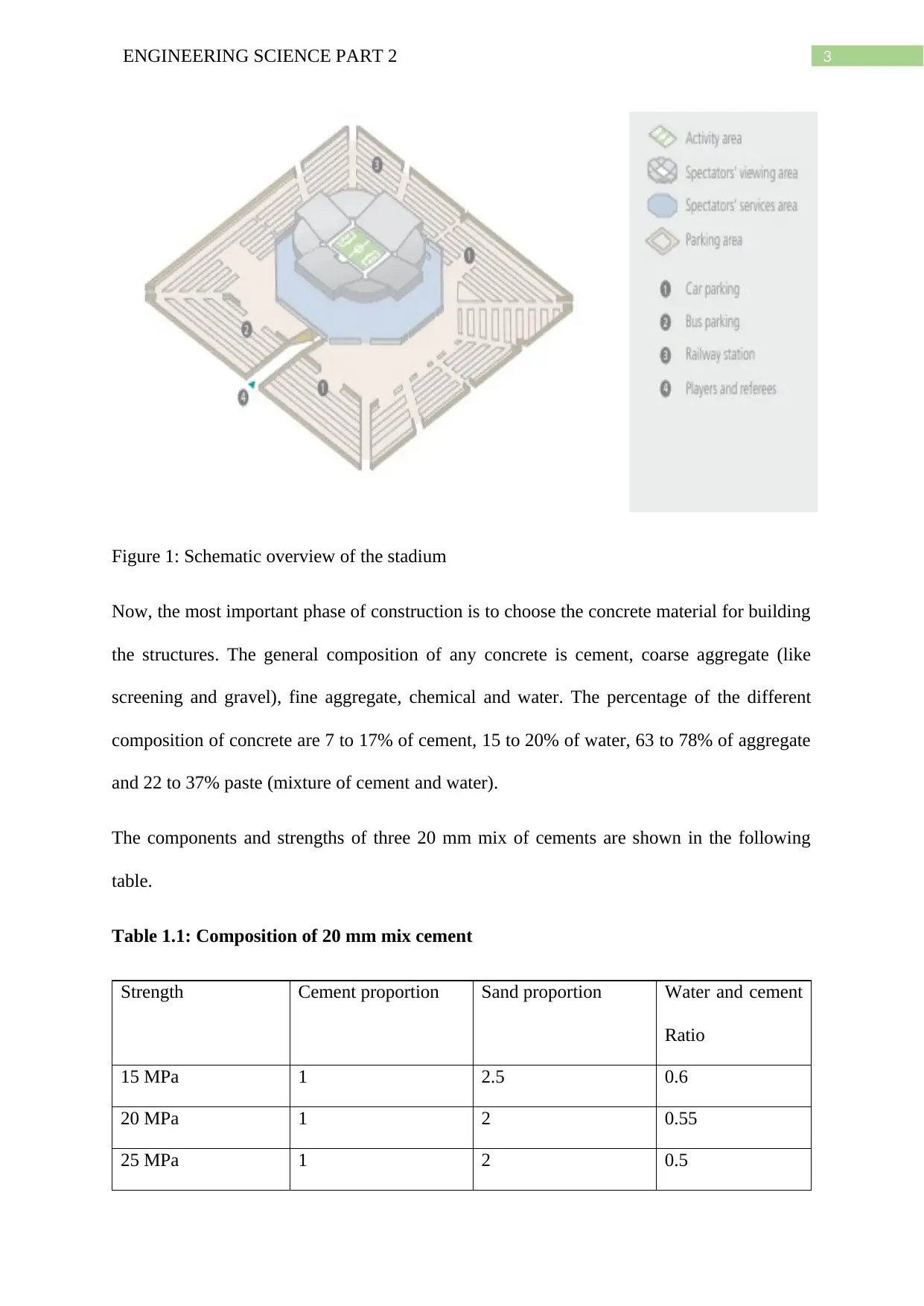
3ENGINEERING SCIENCE PART 2
Figure 1: Schematic overview of the stadium
Now, the most important phase of construction is to choose the concrete material for building
the structures. The general composition of any concrete is cement, coarse aggregate (like
screening and gravel), fine aggregate, chemical and water. The percentage of the different
composition of concrete are 7 to 17% of cement, 15 to 20% of water, 63 to 78% of aggregate
and 22 to 37% paste (mixture of cement and water).
The components and strengths of three 20 mm mix of cements are shown in the following
table.
Table 1.1: Composition of 20 mm mix cement
Strength Cement proportion Sand proportion Water and cement
Ratio
15 MPa 1 2.5 0.6
20 MPa 1 2 0.55
25 MPa 1 2 0.5
Figure 1: Schematic overview of the stadium
Now, the most important phase of construction is to choose the concrete material for building
the structures. The general composition of any concrete is cement, coarse aggregate (like
screening and gravel), fine aggregate, chemical and water. The percentage of the different
composition of concrete are 7 to 17% of cement, 15 to 20% of water, 63 to 78% of aggregate
and 22 to 37% paste (mixture of cement and water).
The components and strengths of three 20 mm mix of cements are shown in the following
table.
Table 1.1: Composition of 20 mm mix cement
Strength Cement proportion Sand proportion Water and cement
Ratio
15 MPa 1 2.5 0.6
20 MPa 1 2 0.55
25 MPa 1 2 0.5
Paraphrase This Document
Need a fresh take? Get an instant paraphrase of this document with our AI Paraphraser
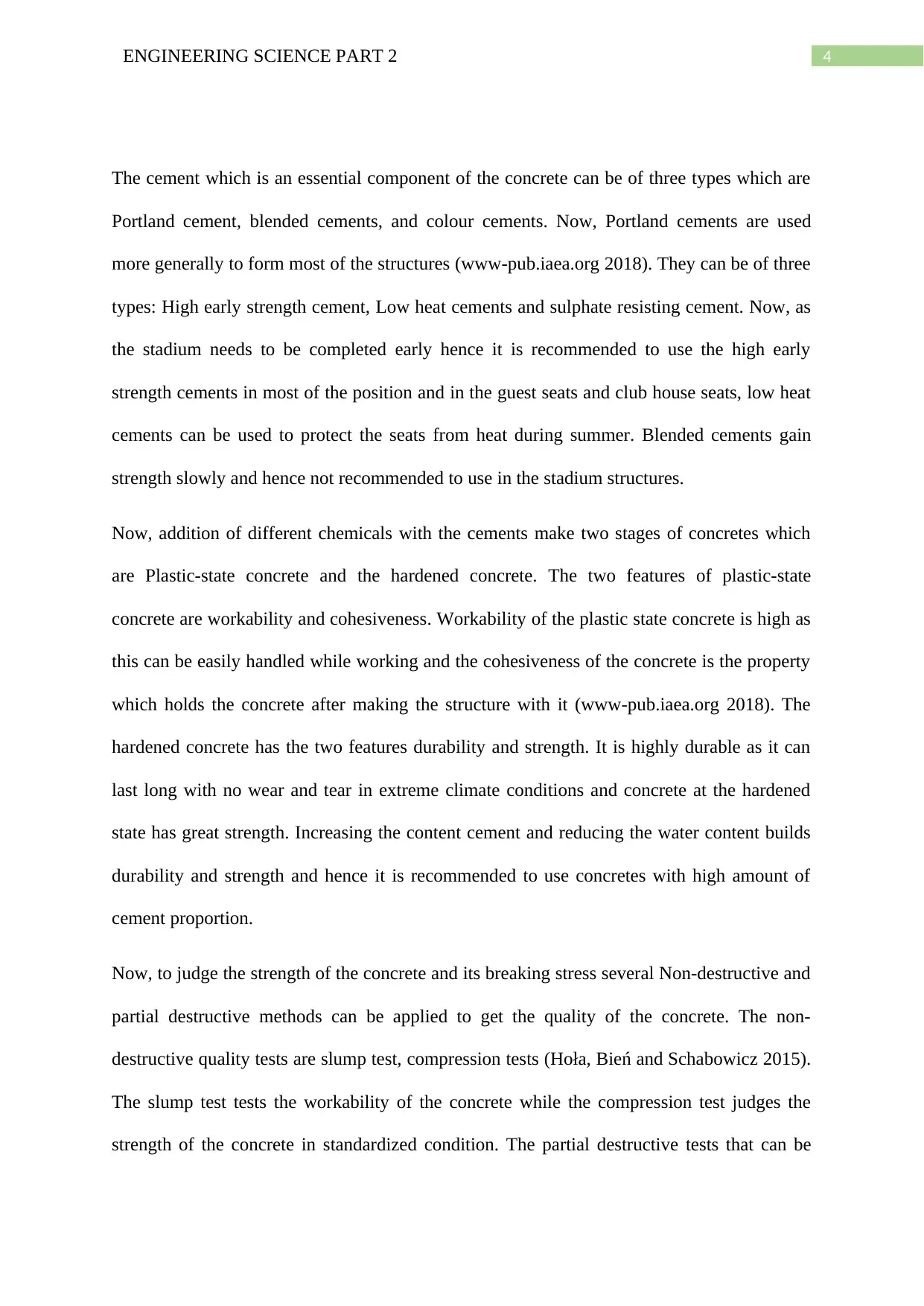
4ENGINEERING SCIENCE PART 2
The cement which is an essential component of the concrete can be of three types which are
Portland cement, blended cements, and colour cements. Now, Portland cements are used
more generally to form most of the structures (www-pub.iaea.org 2018). They can be of three
types: High early strength cement, Low heat cements and sulphate resisting cement. Now, as
the stadium needs to be completed early hence it is recommended to use the high early
strength cements in most of the position and in the guest seats and club house seats, low heat
cements can be used to protect the seats from heat during summer. Blended cements gain
strength slowly and hence not recommended to use in the stadium structures.
Now, addition of different chemicals with the cements make two stages of concretes which
are Plastic-state concrete and the hardened concrete. The two features of plastic-state
concrete are workability and cohesiveness. Workability of the plastic state concrete is high as
this can be easily handled while working and the cohesiveness of the concrete is the property
which holds the concrete after making the structure with it (www-pub.iaea.org 2018). The
hardened concrete has the two features durability and strength. It is highly durable as it can
last long with no wear and tear in extreme climate conditions and concrete at the hardened
state has great strength. Increasing the content cement and reducing the water content builds
durability and strength and hence it is recommended to use concretes with high amount of
cement proportion.
Now, to judge the strength of the concrete and its breaking stress several Non-destructive and
partial destructive methods can be applied to get the quality of the concrete. The non-
destructive quality tests are slump test, compression tests (Hoła, Bień and Schabowicz 2015).
The slump test tests the workability of the concrete while the compression test judges the
strength of the concrete in standardized condition. The partial destructive tests that can be
The cement which is an essential component of the concrete can be of three types which are
Portland cement, blended cements, and colour cements. Now, Portland cements are used
more generally to form most of the structures (www-pub.iaea.org 2018). They can be of three
types: High early strength cement, Low heat cements and sulphate resisting cement. Now, as
the stadium needs to be completed early hence it is recommended to use the high early
strength cements in most of the position and in the guest seats and club house seats, low heat
cements can be used to protect the seats from heat during summer. Blended cements gain
strength slowly and hence not recommended to use in the stadium structures.
Now, addition of different chemicals with the cements make two stages of concretes which
are Plastic-state concrete and the hardened concrete. The two features of plastic-state
concrete are workability and cohesiveness. Workability of the plastic state concrete is high as
this can be easily handled while working and the cohesiveness of the concrete is the property
which holds the concrete after making the structure with it (www-pub.iaea.org 2018). The
hardened concrete has the two features durability and strength. It is highly durable as it can
last long with no wear and tear in extreme climate conditions and concrete at the hardened
state has great strength. Increasing the content cement and reducing the water content builds
durability and strength and hence it is recommended to use concretes with high amount of
cement proportion.
Now, to judge the strength of the concrete and its breaking stress several Non-destructive and
partial destructive methods can be applied to get the quality of the concrete. The non-
destructive quality tests are slump test, compression tests (Hoła, Bień and Schabowicz 2015).
The slump test tests the workability of the concrete while the compression test judges the
strength of the concrete in standardized condition. The partial destructive tests that can be

5ENGINEERING SCIENCE PART 2
employed are Pull-out test, Pull-off test, Core test (www-pub.iaea.org 2018). The pull-out test
can be of two types 1) Danish Lok Test: A head is emerged into the concrete when it is in
use. The test gives a good indication of the compressive strength of the concrete. 2) BRE
pull-out test: In this test a hole is drilled inside the concrete structure and then a fixed object
is pushed into it and then pulled out. This test does not require the head to be casted in the
structure of concrete, but it measures the tensile strength by some calibration standard it is
then converted into the compressive strength by some calibration standards. The schematic
representation of the pull-out test is given below.
Figure 2: Schematic of a general Pull-out test
Now, core test is Pull-out test in which the cores of broken sample structures made from the
concrete during construction are gathered using a diamond headed cutter and then cooled
with water (www-pub.iaea.org 2018). The properties of those cores are then examined which
employed are Pull-out test, Pull-off test, Core test (www-pub.iaea.org 2018). The pull-out test
can be of two types 1) Danish Lok Test: A head is emerged into the concrete when it is in
use. The test gives a good indication of the compressive strength of the concrete. 2) BRE
pull-out test: In this test a hole is drilled inside the concrete structure and then a fixed object
is pushed into it and then pulled out. This test does not require the head to be casted in the
structure of concrete, but it measures the tensile strength by some calibration standard it is
then converted into the compressive strength by some calibration standards. The schematic
representation of the pull-out test is given below.
Figure 2: Schematic of a general Pull-out test
Now, core test is Pull-out test in which the cores of broken sample structures made from the
concrete during construction are gathered using a diamond headed cutter and then cooled
with water (www-pub.iaea.org 2018). The properties of those cores are then examined which
⊘ This is a preview!⊘
Do you want full access?
Subscribe today to unlock all pages.

Trusted by 1+ million students worldwide
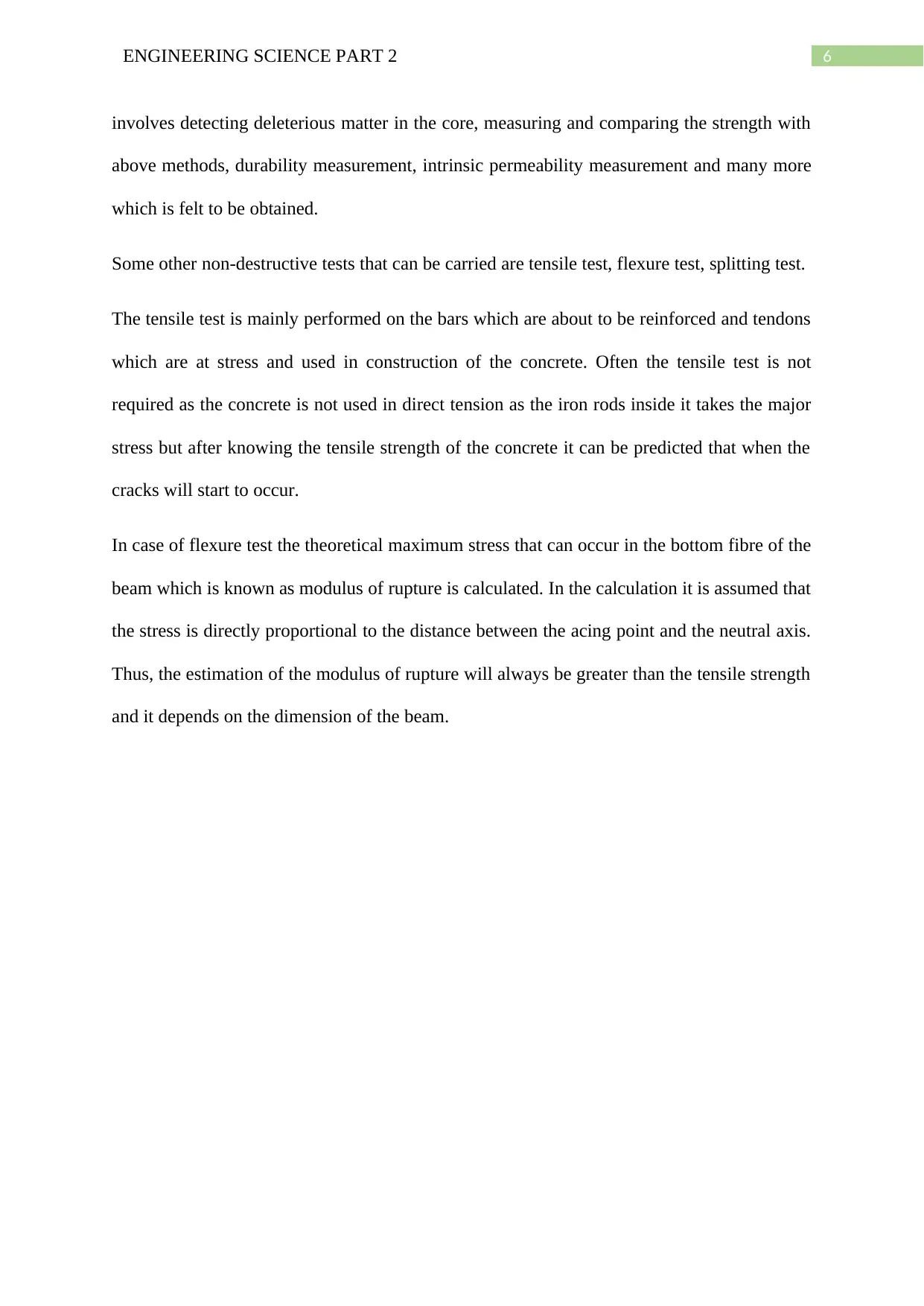
6ENGINEERING SCIENCE PART 2
involves detecting deleterious matter in the core, measuring and comparing the strength with
above methods, durability measurement, intrinsic permeability measurement and many more
which is felt to be obtained.
Some other non-destructive tests that can be carried are tensile test, flexure test, splitting test.
The tensile test is mainly performed on the bars which are about to be reinforced and tendons
which are at stress and used in construction of the concrete. Often the tensile test is not
required as the concrete is not used in direct tension as the iron rods inside it takes the major
stress but after knowing the tensile strength of the concrete it can be predicted that when the
cracks will start to occur.
In case of flexure test the theoretical maximum stress that can occur in the bottom fibre of the
beam which is known as modulus of rupture is calculated. In the calculation it is assumed that
the stress is directly proportional to the distance between the acing point and the neutral axis.
Thus, the estimation of the modulus of rupture will always be greater than the tensile strength
and it depends on the dimension of the beam.
involves detecting deleterious matter in the core, measuring and comparing the strength with
above methods, durability measurement, intrinsic permeability measurement and many more
which is felt to be obtained.
Some other non-destructive tests that can be carried are tensile test, flexure test, splitting test.
The tensile test is mainly performed on the bars which are about to be reinforced and tendons
which are at stress and used in construction of the concrete. Often the tensile test is not
required as the concrete is not used in direct tension as the iron rods inside it takes the major
stress but after knowing the tensile strength of the concrete it can be predicted that when the
cracks will start to occur.
In case of flexure test the theoretical maximum stress that can occur in the bottom fibre of the
beam which is known as modulus of rupture is calculated. In the calculation it is assumed that
the stress is directly proportional to the distance between the acing point and the neutral axis.
Thus, the estimation of the modulus of rupture will always be greater than the tensile strength
and it depends on the dimension of the beam.
Paraphrase This Document
Need a fresh take? Get an instant paraphrase of this document with our AI Paraphraser
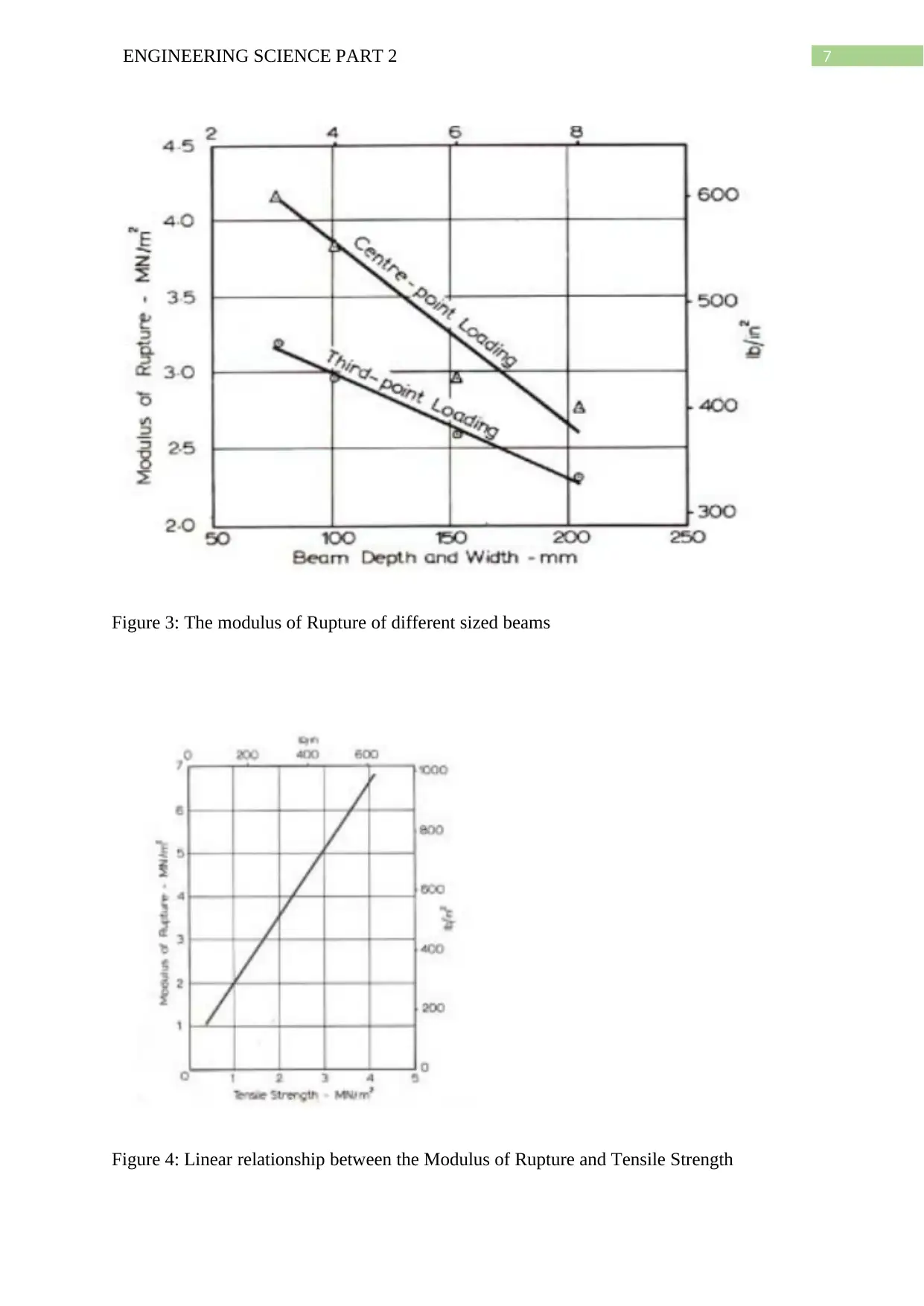
7ENGINEERING SCIENCE PART 2
Figure 3: The modulus of Rupture of different sized beams
Figure 4: Linear relationship between the Modulus of Rupture and Tensile Strength
Figure 3: The modulus of Rupture of different sized beams
Figure 4: Linear relationship between the Modulus of Rupture and Tensile Strength

8ENGINEERING SCIENCE PART 2
Beside these tests the chemical test which determines the chemical composition of the
concrete structure is useful to have an idea about the condition of the concrete, durability and
how suitable it is for continuous use. The ratio of splitting strength to compressive strength
with respect to compressive strength is shown for different composition chemicals and for
different countries Denmark, Brazil, Japan and US(Gravel).
Figure 5: The relation between Ratio and Compressive strength for different chemicals
Now, for choosing the right concrete for building the stadium the above one or more partial
destructive or non-destructive tests can be performed. The concrete chosen should be enough
sustainable, durable and cohesive to hold the structures of the stadium uncracked for at least
15 to 20 years. Hence, by the above results and graphs obtained previously in the published
articles it is assumed that the concrete with high early strength cement will be suitable one for
building the stadium.
The electric power requirement in the stadium is huge as enough power should be uniformly
distributed in the 8 light-stands and power to guesthouse, clubhouse, Big Screen Tv in the
field, lights in the pantry. Apart from that a renewable energy system must be installed that
Beside these tests the chemical test which determines the chemical composition of the
concrete structure is useful to have an idea about the condition of the concrete, durability and
how suitable it is for continuous use. The ratio of splitting strength to compressive strength
with respect to compressive strength is shown for different composition chemicals and for
different countries Denmark, Brazil, Japan and US(Gravel).
Figure 5: The relation between Ratio and Compressive strength for different chemicals
Now, for choosing the right concrete for building the stadium the above one or more partial
destructive or non-destructive tests can be performed. The concrete chosen should be enough
sustainable, durable and cohesive to hold the structures of the stadium uncracked for at least
15 to 20 years. Hence, by the above results and graphs obtained previously in the published
articles it is assumed that the concrete with high early strength cement will be suitable one for
building the stadium.
The electric power requirement in the stadium is huge as enough power should be uniformly
distributed in the 8 light-stands and power to guesthouse, clubhouse, Big Screen Tv in the
field, lights in the pantry. Apart from that a renewable energy system must be installed that
⊘ This is a preview!⊘
Do you want full access?
Subscribe today to unlock all pages.

Trusted by 1+ million students worldwide
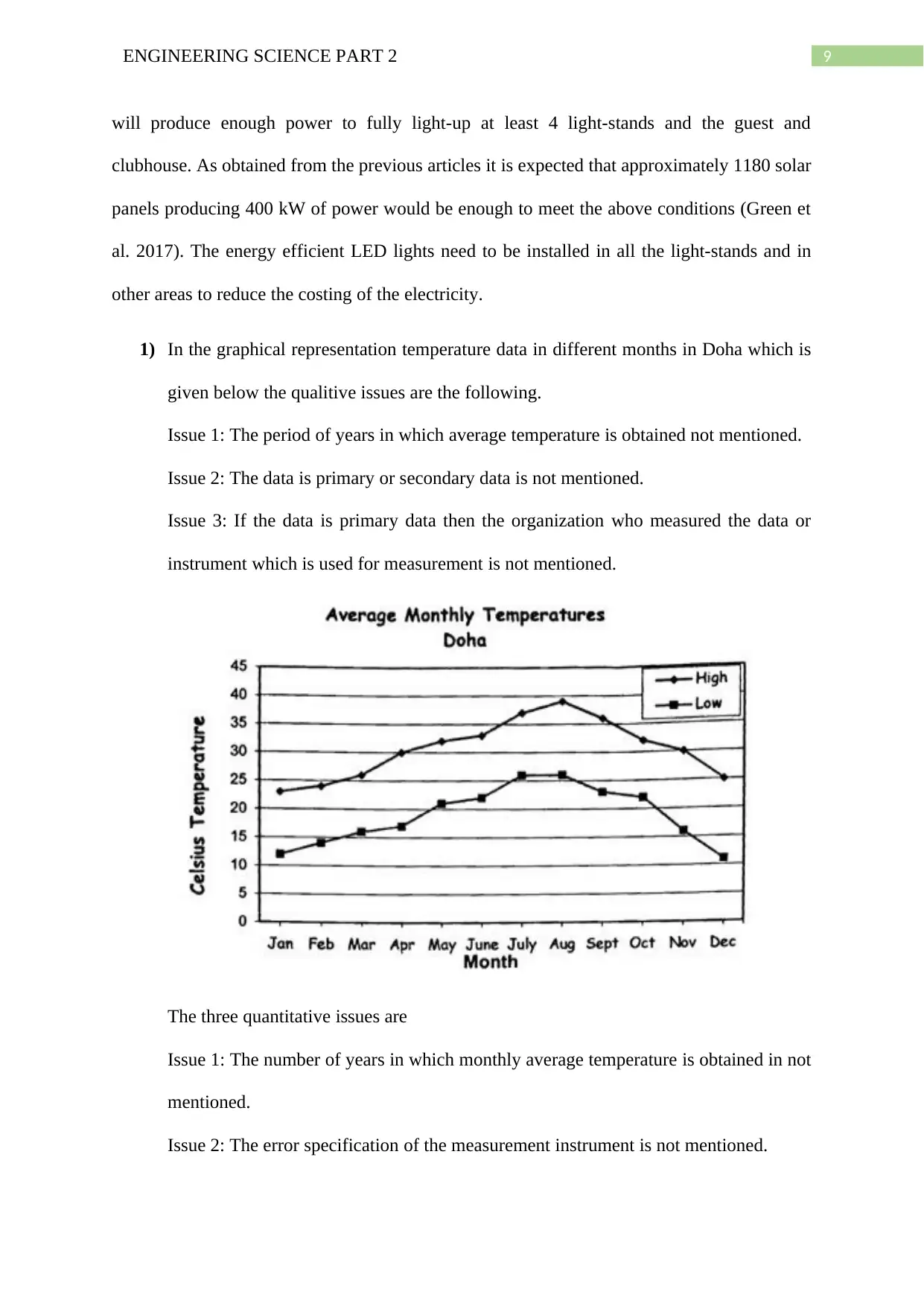
9ENGINEERING SCIENCE PART 2
will produce enough power to fully light-up at least 4 light-stands and the guest and
clubhouse. As obtained from the previous articles it is expected that approximately 1180 solar
panels producing 400 kW of power would be enough to meet the above conditions (Green et
al. 2017). The energy efficient LED lights need to be installed in all the light-stands and in
other areas to reduce the costing of the electricity.
1) In the graphical representation temperature data in different months in Doha which is
given below the qualitive issues are the following.
Issue 1: The period of years in which average temperature is obtained not mentioned.
Issue 2: The data is primary or secondary data is not mentioned.
Issue 3: If the data is primary data then the organization who measured the data or
instrument which is used for measurement is not mentioned.
The three quantitative issues are
Issue 1: The number of years in which monthly average temperature is obtained in not
mentioned.
Issue 2: The error specification of the measurement instrument is not mentioned.
will produce enough power to fully light-up at least 4 light-stands and the guest and
clubhouse. As obtained from the previous articles it is expected that approximately 1180 solar
panels producing 400 kW of power would be enough to meet the above conditions (Green et
al. 2017). The energy efficient LED lights need to be installed in all the light-stands and in
other areas to reduce the costing of the electricity.
1) In the graphical representation temperature data in different months in Doha which is
given below the qualitive issues are the following.
Issue 1: The period of years in which average temperature is obtained not mentioned.
Issue 2: The data is primary or secondary data is not mentioned.
Issue 3: If the data is primary data then the organization who measured the data or
instrument which is used for measurement is not mentioned.
The three quantitative issues are
Issue 1: The number of years in which monthly average temperature is obtained in not
mentioned.
Issue 2: The error specification of the measurement instrument is not mentioned.
Paraphrase This Document
Need a fresh take? Get an instant paraphrase of this document with our AI Paraphraser
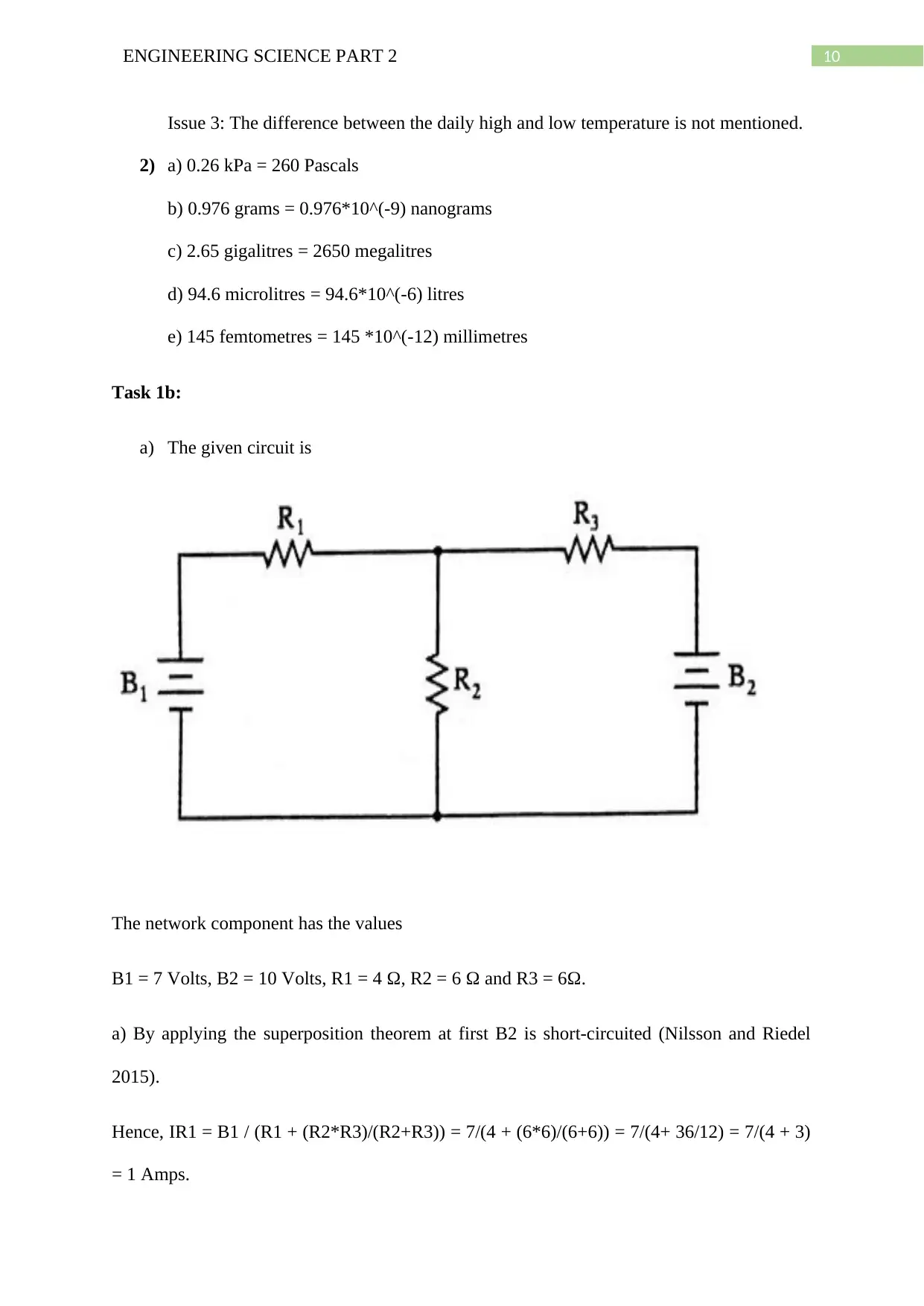
10ENGINEERING SCIENCE PART 2
Issue 3: The difference between the daily high and low temperature is not mentioned.
2) a) 0.26 kPa = 260 Pascals
b) 0.976 grams = 0.976*10^(-9) nanograms
c) 2.65 gigalitres = 2650 megalitres
d) 94.6 microlitres = 94.6*10^(-6) litres
e) 145 femtometres = 145 *10^(-12) millimetres
Task 1b:
a) The given circuit is
The network component has the values
B1 = 7 Volts, B2 = 10 Volts, R1 = 4 Ω, R2 = 6 Ω and R3 = 6Ω.
a) By applying the superposition theorem at first B2 is short-circuited (Nilsson and Riedel
2015).
Hence, IR1 = B1 / (R1 + (R2*R3)/(R2+R3)) = 7/(4 + (6*6)/(6+6)) = 7/(4+ 36/12) = 7/(4 + 3)
= 1 Amps.
Issue 3: The difference between the daily high and low temperature is not mentioned.
2) a) 0.26 kPa = 260 Pascals
b) 0.976 grams = 0.976*10^(-9) nanograms
c) 2.65 gigalitres = 2650 megalitres
d) 94.6 microlitres = 94.6*10^(-6) litres
e) 145 femtometres = 145 *10^(-12) millimetres
Task 1b:
a) The given circuit is
The network component has the values
B1 = 7 Volts, B2 = 10 Volts, R1 = 4 Ω, R2 = 6 Ω and R3 = 6Ω.
a) By applying the superposition theorem at first B2 is short-circuited (Nilsson and Riedel
2015).
Hence, IR1 = B1 / (R1 + (R2*R3)/(R2+R3)) = 7/(4 + (6*6)/(6+6)) = 7/(4+ 36/12) = 7/(4 + 3)
= 1 Amps.
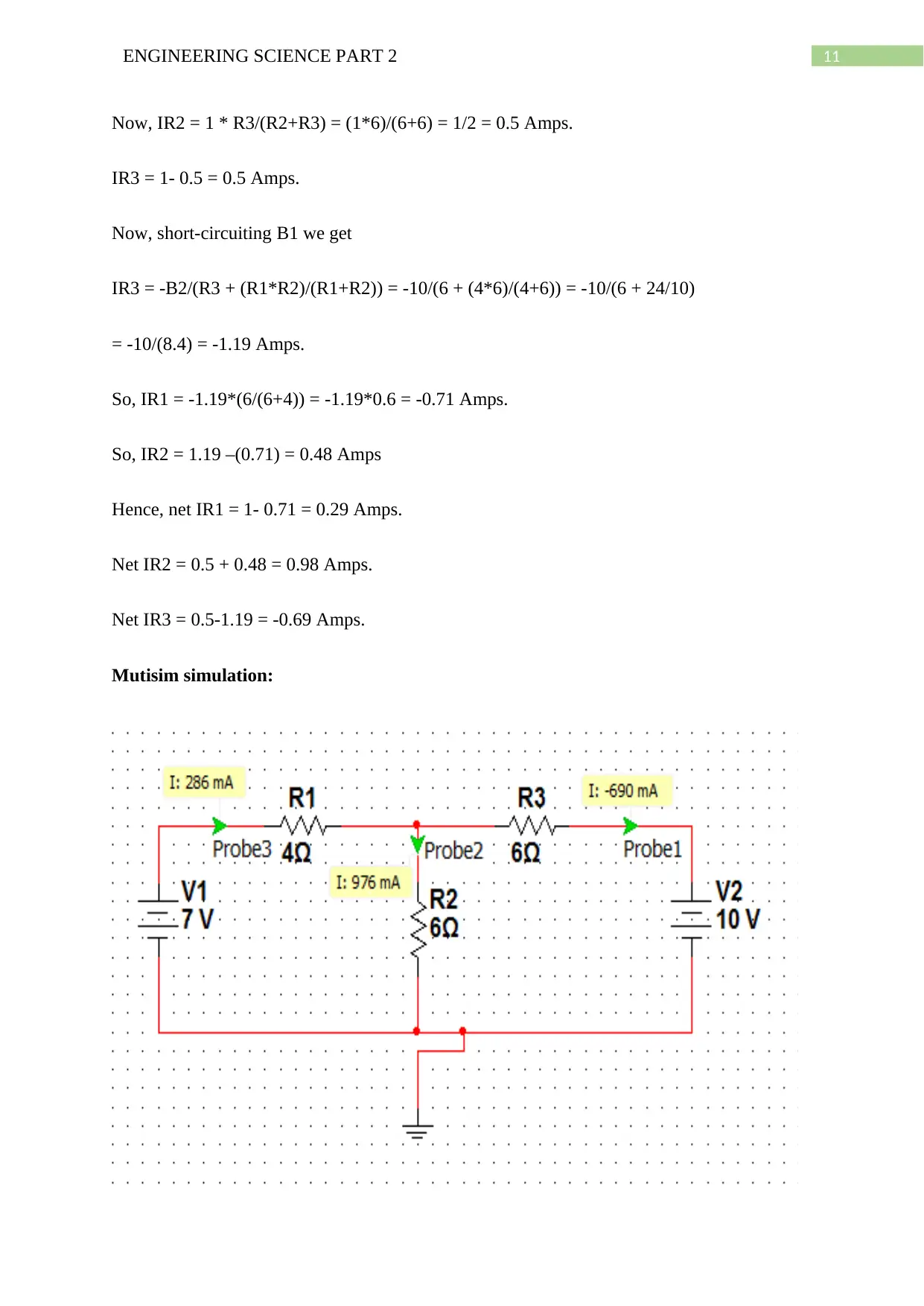
11ENGINEERING SCIENCE PART 2
Now, IR2 = 1 * R3/(R2+R3) = (1*6)/(6+6) = 1/2 = 0.5 Amps.
IR3 = 1- 0.5 = 0.5 Amps.
Now, short-circuiting B1 we get
IR3 = -B2/(R3 + (R1*R2)/(R1+R2)) = -10/(6 + (4*6)/(4+6)) = -10/(6 + 24/10)
= -10/(8.4) = -1.19 Amps.
So, IR1 = -1.19*(6/(6+4)) = -1.19*0.6 = -0.71 Amps.
So, IR2 = 1.19 –(0.71) = 0.48 Amps
Hence, net IR1 = 1- 0.71 = 0.29 Amps.
Net IR2 = 0.5 + 0.48 = 0.98 Amps.
Net IR3 = 0.5-1.19 = -0.69 Amps.
Mutisim simulation:
Now, IR2 = 1 * R3/(R2+R3) = (1*6)/(6+6) = 1/2 = 0.5 Amps.
IR3 = 1- 0.5 = 0.5 Amps.
Now, short-circuiting B1 we get
IR3 = -B2/(R3 + (R1*R2)/(R1+R2)) = -10/(6 + (4*6)/(4+6)) = -10/(6 + 24/10)
= -10/(8.4) = -1.19 Amps.
So, IR1 = -1.19*(6/(6+4)) = -1.19*0.6 = -0.71 Amps.
So, IR2 = 1.19 –(0.71) = 0.48 Amps
Hence, net IR1 = 1- 0.71 = 0.29 Amps.
Net IR2 = 0.5 + 0.48 = 0.98 Amps.
Net IR3 = 0.5-1.19 = -0.69 Amps.
Mutisim simulation:
⊘ This is a preview!⊘
Do you want full access?
Subscribe today to unlock all pages.

Trusted by 1+ million students worldwide
1 out of 16
Related Documents
Your All-in-One AI-Powered Toolkit for Academic Success.
+13062052269
info@desklib.com
Available 24*7 on WhatsApp / Email
![[object Object]](/_next/static/media/star-bottom.7253800d.svg)
Unlock your academic potential
Copyright © 2020–2025 A2Z Services. All Rights Reserved. Developed and managed by ZUCOL.





